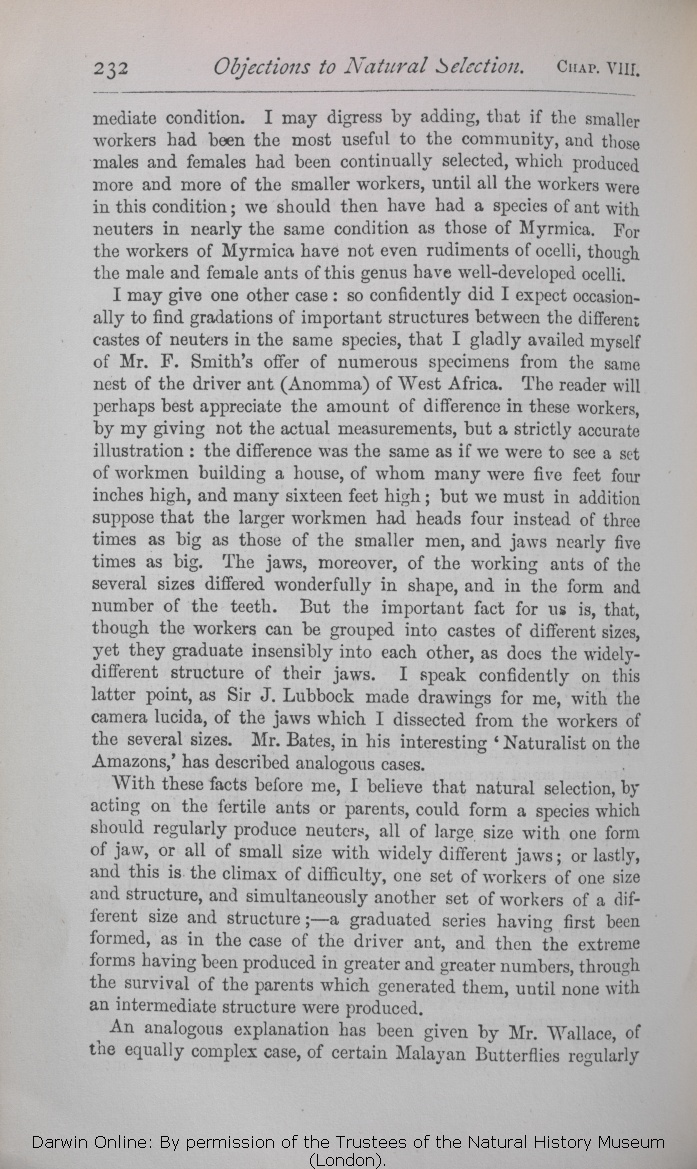condition. I may digress by adding, that if the smaller workers had been the most useful to the community, and those males and females had been continually selected, which produced more and more of the smaller workers, until all the workers
were | were 1869 1872 |
| had come to be 1859 1860 1861 1866 |
| in 1872 | | very 1859 1860 1861 1866 | in 1869 |
| ..... 1872 | | in 1859 1860 1861 1866 1869 |
| as 1872 | | with 1859 1860 1861 1866 1869 |
|
|
I may give one other case: so confidently did I expect
occasionally to | occasionally to 1872 | | to 1859 1860 1861 1866 1869 |
| of 1872 | | in 1859 1860 1861 1866 1869 |
| ..... 1872 | | points of 1859 1860 1861 1866 1869 |
| structures 1872 | | structure 1859 1860 1861 1866 1869 |
| house, 1866 1869 1872 | | house 1859 1860 1861 |
| in addition suppose 1872 |
| suppose 1859 1860 1861 1866 1869 |
| that, 1866 1869 1872 | | that 1859 1860 1861 |
| Sir J. 1866 1869 1872 | | Mr. 1859 1860 1861 |
| me, 1866 1869 1872 | | me 1859 1860 1861 |
| lucida, 1866 1869 1872 | | lucida 1859 1860 1861 |
| ..... 1866 1869 1872 | | had 1859 1860 1861 |
|
|
With these facts before me, I believe that natural selection, by acting on the fertile
ants or parents, | ants or parents, 1869 1872 |
| parents, 1859 1860 1861 1866 |
| ..... 1872 | | either 1859 1860 1861 1866 1869 |
| OMIT 1872 |
| jaws having a 1859 1860 1861 1866 1869 |
| jaws; 1872 | | structure; 1859 1860 1861 1866 1869 |
| the 1869 1872 | | our 1859 1860 1861 1866 |
| simultaneously 1859 1860 1861 1866 1872 |
| at the same time 1869 |
| first been 1869 1872 | | been first 1859 1860 1861 1866 |
| forms 1866 1869 1872 | | forms, 1859 1860 1861 |
| OMIT 1866 1869 1872 |
| from being the most useful to the community, 1859 1860 1861 |
| in greater and greater numbers, 1869 1872 |
| in greater and greater numbers 1859 1860 1861 |
| OMIT 1866 |
| survival 1869 1872 | | natural selection 1859 1860 1861 1866 |
| them, 1866 1869 1872 | | them; 1859 1860 1861 |
| until 1859 1860 1861 1869 1872 |
| in greater and greater numbers, until 1866 |
|
|
An analogous explanation has been given by Mr. Wallace, of the equally complex case, of certain Malayan
butterflies | butterflies 1872 | | Butterflies 1866 1869 |
|









